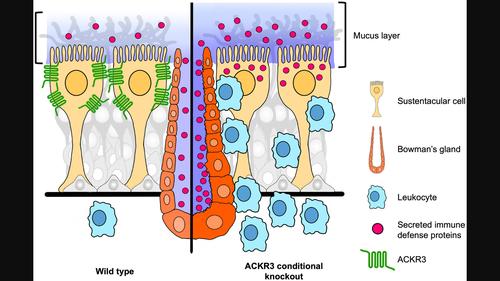Our official English website, www.x-mol.net, welcomes your feedback! (Note: you will need to create a separate account there.)
ACKR3 in olfactory glia cells shapes the immune defense of the olfactory mucosa
Glia ( IF 6.2 ) Pub Date : 2024-03-13 , DOI: 10.1002/glia.24527 André Dietz 1 , Katja Senf 1 , Eva M. Neuhaus 1
Glia ( IF 6.2 ) Pub Date : 2024-03-13 , DOI: 10.1002/glia.24527 André Dietz 1 , Katja Senf 1 , Eva M. Neuhaus 1
Affiliation

|
Barrier-forming olfactory glia cells, termed sustentacular cells, play important roles for immune defense of the olfactory mucosa, for example as entry sites for SARS-CoV-2 and subsequent development of inflammation-induced smell loss. Here we demonstrate that sustentacular cells express ACKR3, a chemokine receptor that functions both as a scavenger of the chemokine CXCL12 and as an activator of alternative signaling pathways. Differential gene expression analysis of bulk RNA sequencing data obtained from WT and ACKR3 conditional knockout mice revealed upregulation of genes involved in immune defense. To map the regulated genes to the different cell types of the olfactory mucosa, we employed biocomputational methods utilizing a single-cell reference atlas. Transcriptome analysis, PCR and immunofluorescence identified up-regulation of NF-κB-related genes, known to amplify inflammatory signaling and to facilitate leukocyte transmigration, in the gliogenic lineage. Accordingly, we found a marked increase in leukocyte-expressed genes and confirmed leukocyte infiltration into the olfactory mucosa. In addition, lack of ACKR3 led to enhanced expression and secretion of early mediators of immune defense by Bowman's glands. As a result, the number of apoptotic cells in the epithelium was decreased. In conclusion, our research underlines the importance of sustentacular cells in immune defense of the olfactory mucosa. Moreover, it identifies ACKR3, a druggable G protein-coupled receptor, as a promising target for modulation of inflammation-associated anosmia.
中文翻译:

嗅觉神经胶质细胞中的 ACKR3 塑造嗅粘膜的免疫防御
形成屏障的嗅觉神经胶质细胞(称为支持细胞)在嗅粘膜的免疫防御中发挥着重要作用,例如作为 SARS-CoV-2 的进入位点以及炎症引起的嗅觉丧失的后续发展。在这里,我们证明支持细胞表达 ACKR3,这是一种趋化因子受体,既可作为趋化因子 CXCL12 的清除剂,又可作为替代信号通路的激活剂。对从 WT 和 ACKR3 条件敲除小鼠获得的大量 RNA 测序数据进行差异基因表达分析,揭示了参与免疫防御的基因上调。为了将调控基因映射到嗅粘膜的不同细胞类型,我们采用了利用单细胞参考图谱的生物计算方法。转录组分析、PCR 和免疫荧光鉴定出神经胶质细胞谱系中 NF-κB 相关基因的上调,这些基因可放大炎症信号并促进白细胞迁移。因此,我们发现白细胞表达基因显着增加,并证实白细胞浸润至嗅粘膜。此外,ACKR3的缺乏导致鲍曼腺免疫防御早期介质的表达和分泌增强。结果,上皮中凋亡细胞的数量减少。总之,我们的研究强调了支持细胞在嗅粘膜免疫防御中的重要性。此外,它还确定了 ACKR3(一种可药物化的 G 蛋白偶联受体)作为调节炎症相关嗅觉丧失的有希望的靶标。
更新日期:2024-03-13
中文翻译:

嗅觉神经胶质细胞中的 ACKR3 塑造嗅粘膜的免疫防御
形成屏障的嗅觉神经胶质细胞(称为支持细胞)在嗅粘膜的免疫防御中发挥着重要作用,例如作为 SARS-CoV-2 的进入位点以及炎症引起的嗅觉丧失的后续发展。在这里,我们证明支持细胞表达 ACKR3,这是一种趋化因子受体,既可作为趋化因子 CXCL12 的清除剂,又可作为替代信号通路的激活剂。对从 WT 和 ACKR3 条件敲除小鼠获得的大量 RNA 测序数据进行差异基因表达分析,揭示了参与免疫防御的基因上调。为了将调控基因映射到嗅粘膜的不同细胞类型,我们采用了利用单细胞参考图谱的生物计算方法。转录组分析、PCR 和免疫荧光鉴定出神经胶质细胞谱系中 NF-κB 相关基因的上调,这些基因可放大炎症信号并促进白细胞迁移。因此,我们发现白细胞表达基因显着增加,并证实白细胞浸润至嗅粘膜。此外,ACKR3的缺乏导致鲍曼腺免疫防御早期介质的表达和分泌增强。结果,上皮中凋亡细胞的数量减少。总之,我们的研究强调了支持细胞在嗅粘膜免疫防御中的重要性。此外,它还确定了 ACKR3(一种可药物化的 G 蛋白偶联受体)作为调节炎症相关嗅觉丧失的有希望的靶标。



























 京公网安备 11010802027423号
京公网安备 11010802027423号